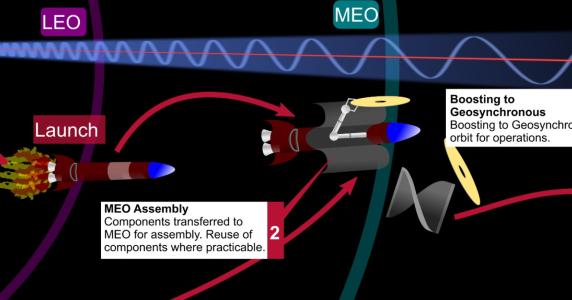An End of Life Strategy for Solar Power Satellites

Space Based Solar Power concepts promise the generation of large amounts of renewable power by launching vast Solar Power Satellites (SPS) into space and beaming the power back to rectennas on Earth. Due to diffraction physics, large scale arrays delivering 2GW of power to the ground will be on the order of a kilometre in length and have masses between 2,000 and 10,000 tonnes. As of January 2020, the amount of debris orbiting the Earth exceeded 8,000 metric tonnes. A decommissioned SPS would therefore have the potential to create a step change in the mass of debris humanity has created.
There is significant interest in pursuing Space Based Solar Power (SBSP) technology, recently renewed due to the need to decarbonise the energy supply in order to achieve Net Zero goals and a recent focus on achieving energy security. Achieving Net Zero targets will require wholesale change to the European energy system and large scale investment. SBSP offers a number of potential advantages over the majority of terrestrial renewables: high-capacity factor, dispatchable power delivered across a large area.
SBSP would represent a key step in humanities progression from scientific exploration in space to exploitation of resources. Terrestrially this type of transition has typically been accompanied, at least eventually, by a greater burden of responsibility on exploiters to limit the environmental damage they leave behind after their activities. SPS operators would have a duty of care to not endanger other space users and to preserve the resource for future generations. In order to achieve this, they will almost certainly be required to sustainably decommission SPS.
Whilst there is still significant work to be done in demonstrating the technical and commercial viability of SBSP, this study seeks to understand the potential routes to decommissioning such massive structures in a sustainable and ethical manner. There is increasing focus in the space industry on regulation around sustainable decommissioning and, by the time any SPS are developed and launched, it is highly likely that they will require a sustainable decommissioning plan. To date, the majority of satellites in Low Earth Orbit (LEO) are left to de-orbit and burn up on their own. Satellites in further away orbits, such as Geostationary Orbit (GEO), are typically boosted by around 300km in ‘graveyards orbits’. However, due to the increased scale of SPS over traditional satellites and greater potential for environmental damage, these options are unlikely to be viewed as acceptable.
As with any decommissioning programme, the key considerations are technical feasibility, cost and environmental impact. In many terrestrial industries, decommissioning is an under-considered part of the project lifecycle as it is typically a significant financial drain on projects and is only carried out due to regulatory requirements. However, because material in space has inherent value from its position at the top of a gravity well, it may be possible for decommissioning of an SPS to pay for itself or even generate a profit. There is an inherent tension in this economic balance: low launch costs are desirable for building an SPS however, a higher launch cost makes the value of orbital assets higher and increases the value that can be recovered from decommissioning activities.
A characterisation of the current leading SPS designs is presented and broken down to a system level. This characterisation shows that many of the leading designs are still lacking key details and knowledge of basic design features such as material selection remain unknown. As such, a detailed breakdown and study of the viability of decommissioning a specific design cannot be conducted.
A framework is presented for assessing macro SPS decommissioning strategies as well as a discussion around the factors affecting individual 10R strategies. Discussion of the feasibility of several processes for applying these strategies to PV and structural components is also provided.
A number of macro strategies for decommissioning have been identified and discussed. Of these strategies most were deemed to be unlikely to be economically viable, technically challenging or result in waste or pollution to either the Earth or space environments.
